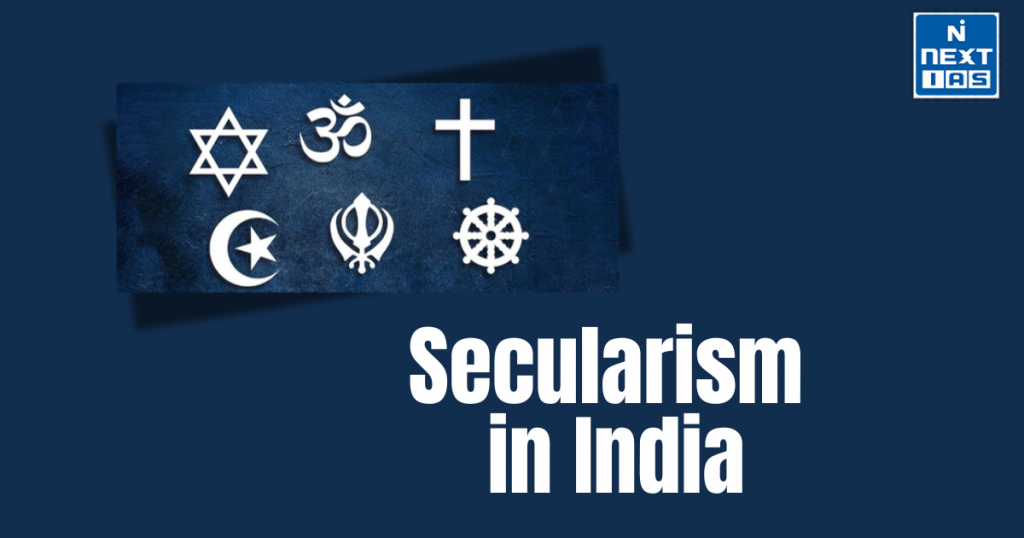
Secularism in India refers to the principle of maintaining religious neutrality by the state while ensuring equal treatment of all religions. Its significance lies in fostering unity, preserving the nation’s diverse cultural fabric, and safeguarding democratic principles in a multi-religious society. This article aims to study in detail the concept, historical roots, constitutional provisions, and challenges associated with secularism in India.
About Secularism in India
- Secularism in India is a foundational principle enshrined in the Indian Constitution, reflecting the nation’s commitment to maintaining religious neutrality and fostering harmony in a multi-religious society.
- Unlike the Western concept of secularism, which emphasizes a strict separation between religion and state, Indian secularism adopts a more inclusive approach.
- It recognizes the importance of religion in the lives of its citizens while ensuring that the state does not favor or discriminate against any religion.
- This unique model of secularism is vital for preserving the unity and integrity of India, a nation characterized by its extraordinary religious diversity.
Historical Context of Secularism
- The roots of secularism in India can be traced to its rich and pluralistic history.
- Ancient Indian society, shaped by traditions like Hinduism, Buddhism, Jainism, and later Islam and Christianity, fostered a culture of tolerance and coexistence.
- During the Mughal period, emperors like Akbar promoted policies of religious pluralism.
- However, colonial rule disrupted this harmony, as the British often pursued divide-and-rule policies, accentuating communal divisions for political gains.
- The Indian freedom struggle under leaders like Mahatma Gandhi and Jawaharlal Nehru emphasized secularism as a unifying principle.
- Gandhi’s vision of secularism was rooted in respect for all religions, while Nehru advocated for a rationalist and state-neutral approach.
- These philosophies laid the groundwork for the secular ideals in independent India.
Constitutional Provisions for Secularism in India
The Indian Constitution upholds secularism through various provisions:
- Preamble: The word “secular” was explicitly added to the Preamble by the 42nd Amendment in 1976, declaring India a sovereign, socialist, secular, and democratic republic.
- Fundamental Rights:
- Article 14 guarantees equality before the law, prohibiting discrimination based on religion.
- Article 15 prohibits discrimination on grounds of religion, race, caste, sex, or place of birth.
- Article 25 ensures the right to freedom of religion, allowing individuals to profess, practice, and propagate their faith.
- Article 26 grants religious denominations the freedom to manage their affairs.
- Directive Principles of State Policy: Articles like 44 advocate for a Uniform Civil Code aimed at promoting secular governance in personal laws.
- Article 28: This provision prohibits religious instruction in state-funded educational institutions.
Key Features of Indian Secularism
- Equal Respect for All Religions: Unlike Western secularism, which strictly separates religion and state, Indian secularism allows the state to engage with religious groups to ensure harmony and equality.
- Freedom of Religion: Citizens are free to follow, change, or reject any religion.
- State Neutrality: The state does not officially endorse any religion but intervenes when necessary to ensure justice and equality.
- Interventionist Role: The state has the power to regulate or reform religious practices if they violate fundamental rights, such as the abolition of untouchability and child marriage.
Dimensions of Secularism in India
- Social Dimension: Secularism promotes social harmony by fostering mutual respect among various religious and cultural groups. It acts as a deterrent against societal fragmentation based on religion.
- Political Dimension: Secularism ensures that political power is not monopolized by any single religious group, thereby preserving democratic principles.
- Economic Dimension: By emphasizing equality and justice, secularism strives to eliminate economic discrimination based on religion, ensuring fair opportunities for all.
- Cultural Dimension: Indian secularism safeguards the rich cultural heritage of various religious communities, promoting unity in diversity.
- Educational Dimension: Secularism in education aims to cultivate scientific temper and critical thinking while respecting cultural and religious diversity.
Challenges to Secularism in India
- Communalism: Religious polarisation and communal violence have undermined India’s secular fabric.
- Events like the Partition, the Babri Masjid demolition, and periodic communal riots highlight the challenges of maintaining religious harmony.
- Politicization of Religion: Political parties and leaders often exploit religious sentiments to garner votes, eroding the secular ideals of the state.
- Religious Fundamentalism: The rise of extremist ideologies among various religious groups poses a threat to secularism.
- Judicial Interpretation: Court judgments on religious matters sometimes generate controversy, creating tensions between secular principles and religious freedoms.
- Uniform Civil Code (UCC): The implementation of a UCC remains a contentious issue, with some arguing it is essential for secularism, while others view it as an infringement on religious autonomy.
- Caste and Religious Discrimination: Persistent caste-based discrimination and religious intolerance continue to challenge the secular ethos of the nation.
Secularism and Global Context
- India’s secularism differs significantly from Western models.
- While Western secularism often emphasizes strict church-state separation, India adopts a “principled distance,” allowing state engagement with religion to promote equality and reform.
- This model is crucial for India’s diverse society but also makes it more susceptible to political and social challenges.
Secularism in Practice: Successes and Failures
Successes
- India has largely maintained its secular character despite being home to multiple major religions.
- Laws and policies like the Right to Education and anti-discrimination acts uphold secular values.
- Judicial interventions, such as the Shah Bano case and the abolition of triple talaq, aim to balance religious freedoms with constitutional principles.
Failures
- Instances of religious violence, such as the Gujarat riots (2002) and Delhi riots (2020), expose the fragility of India’s secularism.
- Political appeasement of certain religious groups undermines the neutrality of the state.
Way Forward
- Strengthening Legal Frameworks: Enacting and enforcing stricter laws against hate speech and communal violence can help protect secular values.
- Promoting Inclusive Education: Educating citizens about the importance of secularism and fostering interfaith dialogue can enhance mutual understanding and respect.
- Depoliticizing Religion: Political parties should refrain from exploiting religious sentiments and instead focus on development and governance.
- Judicial Oversight: The judiciary must continue to act as the guardian of the Constitution, ensuring that secular principles are upheld.
Conclusion
Secularism in India is not merely a constitutional mandate but a social necessity, given the nation’s rich diversity. While challenges persist, the enduring commitment to secular values by the Indian state and its citizens reflects the strength of this principle. By addressing contemporary challenges through inclusive policies and fostering a culture of mutual respect, India can preserve its unique model of secularism, ensuring unity in diversity for generations to come.
GS - 2





